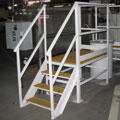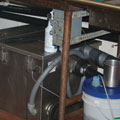
Downtown Phoenix features a new mixed-use commercial development that stretches two city blocks near Chase Field, the home of the Arizona Diamondbacks baseball team.
The expansive development includes a Lucky Strike bowling alley, an Arrogant Butcher restaurant, a Napa Valley-themed grocery store, and a Five Guys Burgers and Fries eatery. Various other retail outlets dot the property.
The presence of multiple food-service establishments meant an efficient solution for the removal of fats, oils and grease was necessary. In similar commercial developments, underground grease interceptors serve multiple food-service establishments. That proved infeasible in this instance due to the requirement of long pipe runs.
Phoenix-basedWJ Maloney Plumbing, along withHighland Tankand its local representativeApplied Process Equipment, decided to still head underground, in a sense, to solve the grease issue. The companies designed and specified a plan calling for the installation of multiple interceptors in a parking garage on the property.
“Phoenix is red-hot and heavy about keeping grease out of the city systems,” WJ Maloney Plumbing Project ManagerAlan Boughton, LEED AP, says. “Without the units we put in, the restaurants wouldn’t go in and that property wouldn’t fly. The parking garage was the best place to put them.”
Block 22 on the property houses a 5,000-gallon Highland Tank interceptor, which caused the elimination of two parking spaces. A 3,000-gallon interceptor will be installed later this year to coincide with the future opening of the chic Kimpton Palomar hotel.
The cutting-edge part of the solution is located in Block 77 of the property and features two Highland Tank AGI-200 GreaseStoppers. The AGIs differ from larger interceptors due to smaller retention capacity and the ability to physically separate grease from water. This particular AGI interceptor has a static water capacity of approximately 350 gallons and features diskimmer wheels that slowly turn and skim grease off at a rate of 40 pounds per hour.
“It holds the grease until it fills up and then pumps it out into a 55-gallon drum,” Boughton explains. “There’s a bigger 100-gallon drum on the first level. When the drum fills up, you take it away and put a new one in. It’s experimental and it’s very cost-effective. They take up far less room than the passive interceptors. There are only three of them in the city. They allowed them in Block 77 to see how they perform. The city wasn’t ready to go all the way with them.”
Currently, two food-service establishments feed into one of the AGIs and a single food-service establishment goes to the other. Block 77 also contains a Highland Tank 1,500-gallon passive interceptor that sits above ground on saddles and is equipped with heat tracing and an electric immersion heater to keep grease from congealing. A built-in lift station chamber fitted with a duplex pump package lifts effluent to the required higher elevation.
In terms of flow, central lines come through the core of the structure into each food-service establishment and then run across the parking lot to the interceptor. The 5,000-gallon interceptor is located below grade and has to pump up to a discharge line.
The design of the system is set up to handle the addition of future establishments requiring FOG removal.
“The trunk lines are all in,” Boughton states. “It’s just a tee off the line to the various retail spaces. We’re just waiting for restaurants to come into spaces. Seven are there right now and I believe another five or six are coming online.”
While it may seem odd to utilize a parking garage for the storage of the interceptors, it turned out to be the perfect solution in this space-challenged setting.
“Gravity and space were not on the side of the clients,” Highland Tank Division ManagerChas Tevisstates. “Locating the grease interceptors on the sidewalks of a busy downtown area was simply not an option. Grease interceptors tend to smell, especially when being serviced. It was not practical to use point-of-use interceptors in this application. Each food-service establishment would require two to four interceptors. They had very few options. They needed grease abatement and this solution provided that.”

Greasing the Pocketbook
Earl Coffmanknows a thing or two about operating restaurants.The 25-year industry veteran has run establishments in Missouri, California, Arkansas and Michigan for chains ranging from Baker’s Square to Denny’s to Coco’s. His current home is Elmer’s, a family-style restaurant in Pocatello, Idaho. Coffman purchased the restaurant seven years ago.
As the result of his food-service establishment travels over the years, Coffman has become educated on the topic of fats, oils and grease removal - particularly when it comes to the bottom line.
“I’ve worked in places with 1,000-gallon (grease) traps,” Coffman notes. “It gets to be a pretty big problem when they are charging $1,500 to dump it and you’re doing that two or three times a year. It’s quite expensive.”
Elmer’s had been using a Josam interceptor for the better part of two decades. A combination of normal wear-and-tear and recent advancements in grease interceptor technology prompted Coffman to retrofit the older unit with a Josam GI 2000 series interceptor, which separates the grease from the water.
“There is a probe inside the unit that measures the level of grease that has settled at the top,”JosamDirector of EngineeringBrian Tubaughexplains. “Once it reaches a certain level, it sends a signal to start the pumping cycle. Heaters turn on to heat up the grease and water to make sure the grease is liquid. At a certain temperature, the pump turns on, pulls the grease layer off the top layer of water and pumps it into a reclaim tank. It’s much easier to dispose of when the grease is outside the interceptor.”
Coffman is a fan of the newer technology due to ease of use and, most importantly, cost.
“The only thing you really have to do is disconnect the one storage tank and someone comes by and takes the grease out of the one that is full,” he says. “I have two 55-gallon tanks so when one gets picked up the other one can be used. We probably will have it cleaned four times a year and it’s only $75 a pop.”
The interceptor at Elmer’s is located by the dish station. Coffman is a proponent of having the device installed inside the facility when possible.
“I’ve managed other restaurants where you have these traps outside and you start getting the smell back into the restaurant. It smells like the restroom is in the dining room,” he says. “This one sits underneath the counter. You turn it on and it goes by itself.”
Coffman has become quite popular in town since the retrofit.
“Other businesses have heard about it and have come over to take a look at it,” he says.

